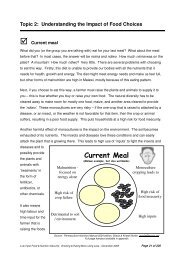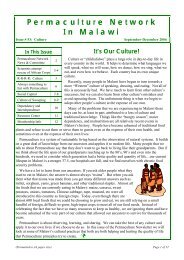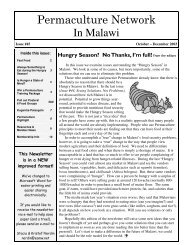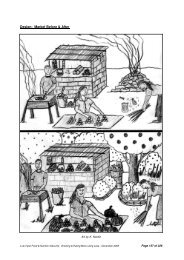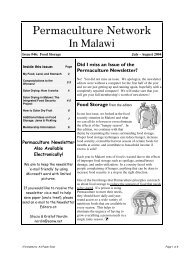Permaculture, Final Capstone Paper 5-26, Hope - Never Ending Food
Permaculture, Final Capstone Paper 5-26, Hope - Never Ending Food
Permaculture, Final Capstone Paper 5-26, Hope - Never Ending Food
Create successful ePaper yourself
Turn your PDF publications into a flip-book with our unique Google optimized e-Paper software.
Table 1: Comparative<br />
Practices<br />
Water<br />
Pest / Disease<br />
Management<br />
Trees / Agroforestry<br />
Animal Husbandry /<br />
Livestock Farming<br />
Diet<br />
Common Malawian Practice<br />
• Water is used once and then dumped on unproductive<br />
ground.<br />
• Rainwater is unmanaged causing crop loss, damage to<br />
homes and structure, and contributing to massive soil<br />
erosion.<br />
• When possible apply chemical pesticides and<br />
herbicides for weed and pest control.<br />
• If chemicals are unattainable, farmers may rely solely<br />
on laborious reactive measures (ex. removing<br />
caterpillars & snails by hand when the problem occurs)<br />
• No fence or fence constructed from dead<br />
wood/material<br />
• Fatalistic attitude: “It is God’s will”<br />
• Importance of trees is known, but few trees are planted.<br />
• Trees planted or desired to plant include Gmelina or<br />
Eucalyptus which were promoted by the colonial<br />
government. These trees disturb agricultural<br />
production.<br />
• Few farmers plant fruit trees<br />
• Firewood is collected from far away and significantly<br />
contributes to deforestation.<br />
If animals are kept,<br />
• Roam freely to scavenge for food, often destroying<br />
crops and raiding kitchen gardens<br />
• Manure is not used on to enrich soil because it is too<br />
difficult to collect.<br />
• 75% of daily caloric intake is from staple crop (maize)<br />
resulting in high rates of under-nutrition<br />
• Monoculture cropping has led to high risk of food<br />
insecurity because of a dependency on external inputs,<br />
soil degradation, and high risk of crop failure. (Nordin,<br />
2005)<br />
<strong>Permaculture</strong> Practice<br />
• Water is used as many times as possible (ex. After<br />
washing dishes, water is used for irrigated a garden<br />
bed.<br />
• Non-toxic grey water is used for food production<br />
where appropriate<br />
• Rainwater is harvested and stored for future use either<br />
in the soil or in a holding container<br />
• Preventative measures are taken to reduce<br />
vulnerability and susceptibility to pest and disease.<br />
• Inclusion of strong smelling plants and mulch and use<br />
of strong smelling water<br />
• Encourages beneficial species<br />
• Live fencing<br />
• Proactive, holistic attitude: “You don’t have a snail<br />
problem, you have a duck deficiency” (Mollison,<br />
1997)<br />
• Many different types of trees are planted for food<br />
production, to increase soil fertility, and to conserve<br />
topsoil.<br />
• Farmers plant trees specifically for firewood and<br />
building materials.<br />
• Trees are used as “supporters” in the guild system<br />
thus introducing horizontal plane of agricultural<br />
production.<br />
• Kept in a “khola” (pen) for easy feeding and<br />
collecting of manure.<br />
• Incorporated into the food production system- food is<br />
grown for animals that, in turn, provide food for<br />
humans.<br />
• Proper amounts of six food groups (or five with a<br />
protein source) are consumed on a daily basis.<br />
• Diversified planting increased food and nutrition<br />
security by: reducing dependence on external inputs,<br />
better soil fertility and increased yields.<br />
11



